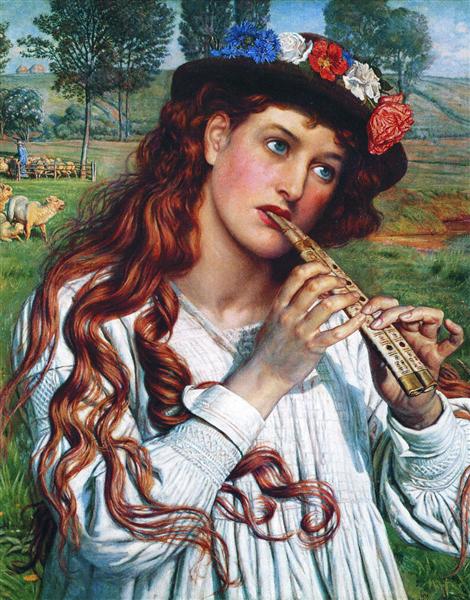Beschreibung
William Holman Hunt's painting "Amaryllis" is a work that embodies the aesthetic ideals of the Pre-Raphaelite Brotherhood, an artistic movement with which Hunt was closely associated. Created in 1870, this work not only reveals the artist's technical mastery, but also serves as a testament to the symbolism and visual richness that characterize his work. In "Amaryllis," Hunt presents a female figure that represents the beauty and fragility of nature, a recurring theme in the works of this movement.
The composition of “Amarilis” is notable for its attention to detail and its connection to the surrounding flora. The main figure is a young woman, who stands in a vibrant natural setting, surrounded by flowers and vegetation, suggesting an intimate connection with the natural world. The woman’s posture, with a pensive expression, evokes a sense of contemplation, almost dreamlike, inviting the viewer to reflect on the relationship between humans and nature. The figure is adorned with a soft dress that blends in with the earthy colors around her, reinforcing the idea of harmony with the environment.
The use of colour is one of the highlights of the work. The vibrant hues of the flowers, which spread across the background of the painting, contrast with the delicate tones of the model's skin, creating a visual interplay that captures the eye. Each petal and leaf appears to have been painted with extreme care, a hallmark of Hunt, who was known for his meticulous approach to the depiction of light and texture in nature.
As for the iconography of the painting, the name “Amaryllis” has poetic and mythological connotations. Amaryllis is a character from Greek mythology, associated with beauty and love. This choice of an evocative name suggests that Hunt’s work is not merely a portrait of a young girl, but also a celebration of the ideals of beauty that permeate nature. The symbolism of flowers and vegetation in the painting can be interpreted as an expression of life in its purest form, as well as a reminder of the transience of beauty.
Hunt's technique, influenced by the Pre-Raphaelite desire to return to medieval painting, is evident in the way each element of the work is interconnected. The thoroughness of the naturalistic depiction and use of colour reflect a commitment to detailed observation and a profound respect for the natural world. Furthermore, the work is imbued with symbolism that invites the viewer to explore deeper meanings beyond the aesthetic surface.
In the context of Hunt's work and the Pre-Raphaelite movement, Amaryllis enters into dialogue with other contemporary paintings that address similar themes of nature and symbolism, such as John Everett Millais' Spring Awakening. Both works share an exploration of the female figure in relation to her natural environment and the deep symbolism that each element contains.
In short, William Holman Hunt's "Amarilis" is a work that transcends the merely pictorial to become a visual journey towards the interpretation of beauty, nature and the fragility of life. Through his composition, use of color and symbolism, Hunt offers a window into a vision of the world where art becomes a vehicle for profound reflection on existence itself. Hunt's technical mastery and his commitment to the representation of the essence of nature ensure "Amarilis" a prominent place in the history of art.
KUADROS ©, a famous painting on your wall.
Hand-made oil painting reproductions, with the quality of professional artists and the distinctive seal of KUADROS ©.
Painting reproduction service with satisfaction guarantee. If you are not completely satisfied with the replica of your painting, we will refund 100% of your money.

